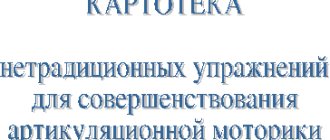One can understand the excitement of parents who suddenly discover that their preschool child speaks some sounds of their native language poorly or not at all. In this case, they are faced with the problem of how to teach the child correct sound pronunciation? Is this acceptable at home? Experts say that parents can do a lot to help a preschooler master correct sound pronunciation. You just need to have certain knowledge: about the causes of poor pronunciation, ways to correct it, ways to teach correct diction.
Why do you have problems pronouncing sibilants?
Certain areas of the brain are responsible for the process of speech development. If their work is disrupted, difficulties arise with the pronunciation of individual sounds. In most cases, the problem is caused by birth injuries. Of particular danger are displacements of the skull bones of the occipital part or vertebrae. As a result, blood circulation in the head area slows down. Brain cells do not receive the required amount of oxygen, which leads to their destruction.
An injury received during childbirth can also provoke pinching of the hypoglossal nerve or disturbances in the associative neural connections of the auditory analyzer. This affects the ability to recognize and reproduce oral speech. For the correct pronunciation of individual sounds, the chewing and facial muscles are no less important. In some cases, speech development in children is slowed down due to injuries received after birth (falling from a sofa, hitting the back of the head, etc.).
Possible deviations
During the examination, it can be revealed that the sound “Ш” is pronounced incorrectly. Despite the fact that this sound is considered dull, it must be pronounced clearly and cleanly.
Possible deviations:
- The child sticks his tongue out too much between his teeth, resulting in a lisping sound.
- Sigmatism in “Ш” appears when there is strong tension in the deep part of the tongue. Then “W” is replaced by “X”.
- With lateral sigmatism, a “pop” is produced.
- Dental parasigmatism - the tongue rests on the upper incisors. Instead of "W" you get "T".
- With labiodental parasigmatism, “W” sounds like “F”.
- Instead of "SH" sounds "S", this is whistling parasigmatism.
It is important to tell your child how the speech organs should be positioned correctly. Classes should be accompanied by visual analogies and demonstrations.
How to teach a child to say the letter “sh”
Young children often have problems pronouncing hissing sounds. Doctors have identified several possible reasons for this phenomenon. The most common of these is incorrect articulation. It represents a certain position of the tongue during pronunciation. Other reasons include:
- Incorrect pronunciation of sounds by parents. The child pronounces them as he hears them from others.
- Limitation of motor activity of the tongue due to a shortened hyoid frenulum.
- Disturbances in the functioning of the hearing aid.
- Anomalies in the structure of the teeth and jaw.
Initially, the cause of a mechanical nature should be eliminated. If the problem is a short frenulum, it is trimmed. It is important to pay attention to your child's bite. In case of deviations, appropriate measures are taken. In other cases, a set of exercises helps to improve speech.
Why doesn't the letter "Ш" hiss?
The reasons for incorrect pronunciation may be the following:
- Physiological: malocclusion, large tongue, high palate. In addition, the quality of the spoken sound depends on the development of the speech apparatus.
- Prolonged use of the pacifier. This item spoils the bite, which leads to distorted pronunciation of whistling and hissing sounds.
- "Lisping" with a child. By repeating after their elders, children distort their speech.
- Repeating incorrect pronunciation after adults who have speech impediments.
- Memory, thinking and attention are poorly developed.
- Speech hearing impairment (in some cases, dyslexia may develop).
If, after homework, the child still cannot pronounce the letter “SH,” you should contact a speech therapist.
Diagnostics
Speech is formed between 3 and 5 years. If problems arise, parents need to take their child to a speech therapist. Diagnosis by a specialist is carried out in a playful way. The doctor determines which sounds the child has problems pronouncing. A visual examination of the articulatory apparatus is also carried out. This includes an examination of the oral cavity. The structure of the jaw, tooth, lips and palate are assessed. During the examination, the child is asked to do the following:
- attempts to reach the chin and nose with the tongue;
- moving the tongue from the left side of the mouth to the right, periodically changing the rhythm of movements;
- pushing the lower jaw forward and then back;
- clicking the tongue;
- the formation of a tube from the lips after they are stretched into a smile.
When is a child’s speech correction needed?
The formation of sound pronunciation begins in the first months of life. The first sounds arise involuntarily; they are usually the easiest to pronounce (“a”, “o”, “u”). Up to 3 years, replacement of sounds and distortions in their pronunciation are considered the age norm. By the age of 5, a full-fledged phonemic range is actively being formed.
If by the age of 5 a child cannot pronounce “sh” correctly, it is necessary to help him with the pronunciation of the sound through articulatory gymnastics and other methods.
The production of the sound “Ш” occurs between the third and fifth years of life. At first, the child’s pronunciation suffers and the sound is unclear. Sometimes children use a whistling C instead of a hissing one.
The most common reasons for delays in the stages of speech pronunciation are: improper development of the speech apparatus (problems with bite or frenulum of the tongue); inactive lower jaw.
To begin the correct formation of sound pronunciation, you first need to understand the sounds that are difficult for a child to pronounce, what the difficulty is. The first to be checked is the group of hissing, whistling and sonorant sounds. To check correctly, you need to ask the child to tell a poem, story, or fairy tale.
You can use special cards with images of the letter that needs to be checked.
Violation of a hard consonant is most often accompanied by incorrect pronunciation of a soft one. In this case, the pronunciation of the sound is checked separately from the word. If in this form the child pronounces the sound correctly, then you need to practice by repeating phrases and words. When it is clear that the sound is distorted, it is necessary to begin work on its production.
How to check the pronunciation of hissing words without a speech therapist
To teach your child to pronounce hissing sounds, you need to set up the correct articulation. But an assessment of the speech apparatus is required first. It is not necessary to visit a speech therapist to identify gaps. This can also be done at home. It is necessary to have a conversation with the child, during which the movements of the baby’s lips and tongue are observed. Normally, when pronouncing the sound “sh” the following is observed:
- the tip of the tongue rises to the palate, forming a small gap;
- the air flow passes through the inactive vocal cords, causing the corresponding sound;
- the lips are pulled forward, forming a tube;
- the lateral edges of the tongue touch the upper teeth.
How can you test a preschooler’s speech at home?
Having determined that a preschooler cannot speak hissing words, parents should contact a specialist. At home, they can also examine the child’s speech to understand which sibilants are distorted. According to speech therapy rules, the examination begins with a separate pronunciation of a certain sound, then it is pronounced in syllables, words, and only then in sentences. For example:
- The parent, asking the child to reproduce the hissing words sh, zh, ch, shch, pronounces them slowly and clearly. It is more interesting to offer a game form in the form of speech exercises: “The snake hissed: sh-sh-sh”, “The bee buzzed: w-w-w.”
- To check the state of sound in syllables, the baby is encouraged to repeat syllables, for example, shi-zhi, cha-sha, zhu-shu, chu-shu, ash-azh, ach-ashch, cabbage soup, chuh, shoo, whack. In this case, the sounds being tested must be at the beginning, middle, and end of the syllable.
- The next step is to check the pronunciation of sounds in words. For interest, pictures are used where objects are drawn for a given sound (cone, giraffe, hut, teapot, pike and others). In this case, you can use speech therapy visual material, or you can choose pictures in children’s books with your child. The main thing is that they comply with certain rules: hissing words must sound clearly in words, stand at the beginning of the word, the middle, the end (fur coat, car, reed). Using the same principle, words with other hissing words are selected: beetle, gun, skis, etc. It would be good if the examination took place in the form of game exercises. For example, “How to call it affectionately (bird-bird, goat-goat, beetle-bug, winter-winter, sun-sun)? »
- The last stage involves checking the sound in a sentence in which several words with the sibilant being tested are selected. Pure sayings serve this purpose well, for example, “Hush, mice, don’t make noise! Don’t wake up the cat!” Classic tongue twisters are suitable for examining hissing ones: “Sasha was walking...”, “Cuckoo cuckoo...”
Important! When examining a child, you need to try to determine the cause of incorrect pronunciation in order to understand what influenced the distortion of diction.
Training the correct pronunciation of hissing words
The production of the sound “sh” is carried out in stages. To achieve the desired results, you need to train constantly. The articulatory gymnastics complex includes exercises for each zone of the speech apparatus.
Warm up your tongue
Language training is especially important in establishing the correct pronunciation of sounds. Its position plays a significant role in the development of speech skills. The most effective exercises include:
- Having closed your teeth, you need to push your tongue through the resulting hole.
- You should smile with your mouth wide open, and then place the edge of your tongue on your lower lip. You need to hold this position for 40 seconds.
- With your mouth slightly open, you need to reach your tongue with your nose. This exercise is repeated at least 5 times.
- Starting position - as in the previous exercise. You need to cover the upper front teeth with your tongue, and then return it to its place.
- With your mouth wide open, you need to raise your tongue to your nose as much as possible, and then lower it to your chin.
- The tongue protrudes from the mouth, and a piece of candy is placed on its tip. The child should try to stick it to the palate directly behind the upper teeth.
Warm up our lips
Regular lip training will help you pronounce sounds correctly in the future. They need to be combined with exercises for other areas of the oral cavity:
- The most effective exercise is the “tube”. The teeth close tightly and the lips extend forward. They should not cover their teeth. You should hold this position for 6 seconds.
- Alternating “smile” and “pipe” exercises. You should smile with your mouth completely closed.
- It is necessary to stretch your lips, trying to round them. After 6 seconds you should return to the starting position.
- The “tube” exercise is first performed in the standard form. After this, the improvised tube should be made larger by slightly opening the lips.
Tongue massage
Speech therapy massage is considered one of the methods for correcting pronunciation. It not only promotes the correct production of sounds, but also accelerates the development of speech in general. Manual treatment reduces salivation and improves the tone of the facial muscles. For skin and colds, massage is contraindicated.
The duration of the first session is 10 minutes. The facial muscles are pre-relaxed. It is important to create favorable conditions so that the child is not distracted by anything. Over time, the duration of the procedure increases to 20-30 minutes. The course of treatment includes 15 visits to a specialist.
Causes of poor sound pronunciation
According to speech therapy standards, correct pronunciation should be formed by middle preschool age. However, even older preschoolers experience diction disorders. Experts provide evidence that children find it most difficult to pronounce hissing sounds: sh, zh, ch, shch. Imperfect diction can manifest itself in incorrect pronunciation of a sound, replacing one with another (machine-masyn), or skipping it. Experts identify the main reasons for poor pronunciation. These include the structure of the speech apparatus, insufficient development of phonemic hearing, perception, and the attitude of parents.
Features of physiology
- inactivity of the articulatory apparatus;
- improperly formed bite,
- short frenulum of the tongue,
- high palate.
Immaturity of phonemic perception
- The preschooler does not distinguish individual sounds by ear and replaces them.
Adult misbehavior
- Give the baby a pacifier for too long, especially during the period when speech is developing (early age);
- prolonged use of a pacifier leads to the formation of a malocclusion, which affects the pronunciation of many sounds, especially hissing sounds;
- deliberate distortion of speech by adults in order, in their opinion, to become understandable to the baby;
- dissatisfaction with the preschooler’s diction and the requirement to speak clearly, without teaching correct articulation;
- possible hearing loss not noticed by parents.
Speech therapy classes
The most successful way to improve speech is to visit a speech therapist. Regular exercises help improve fine motor skills and the formation of an air stream, which plays a significant role in pronouncing sounds. The speech therapist will select a set of exercises based on the individual characteristics of the speech apparatus. Classes include games, learning tongue twisters and manual practices. If a child does not make contact with a stranger, home activities will be the most relevant.
Examination of the pronunciation of the sound “Ш”
When examining pronunciation, a specialist must find out how the sound being tested is pronounced separately, in words, in speech. For this purpose, images whose names include “Ш” can be used. It is important that it occupies different positions and combines with other sounds. The little student is asked to recite a poem in which the words have an "W".
If a child does not clearly pronounce an isolated “Sh”, you must first introduce this sound, and then consolidate its pronunciation in speech. If a child correctly pronounces a separate sound, but the defect is observed only in words, you need to work on consolidating it in speech.
Rules for testing at home:
- The child is in a calm state, repeating the necessary words after one of the parents. When forced into pronunciation, the sound is often distorted.
- The child pronounces the desired sound more than once. Sometimes children, even if they have a defect, can imitate the correct sound and the violation is not immediately noticed. It is easier to hear defective pronunciation in words where “Ш” is pronounced together with other consonants. To check, the child should pronounce the following words: chestnut, muffler, punch, mouthpiece.
For some children, the problem can be overcome in the first lessons; for others, the defect is dealt with step by step over some time, selecting appropriate tasks and techniques.
Making the sound "zh"
During classes, a speech therapist can identify any sound that is problematic for the child. Articulation exercises are carried out to allow the baby to understand how the tongue and lips should be positioned to correctly pronounce hissing words. The vocal cords must be brought into a state of tension during pronunciation. The lips move forward slightly and are rounded. The tip of the tongue is applied to the front of the palate, forming a small gap. When pronouncing the sound “zh”, the air stream can be easily felt by raising your palm to your mouth. Before the exercises, the pronunciation of the sound “sh” is trained, since it is considered the same as “zh” in articulation.
Stage 2. Gymnastics for the articulatory apparatus
Lip exercises
To warm up your lips, you can use speech therapy exercises:
- “We’ll be surprised and laugh.” The preschool child alternately makes a wide and narrow tube with his lips. A wide tube is in the “o” state, a “narrow” tube is in the “y” state. Nothing is said out loud, only the lips work.
- "Smile tube" Alternately, the child smiles widely, then makes a movement with his lips like the sound “o”.
Tongue exercises
Classic exercises are also used to train the tongue:
- “Delicious jam”, in which the tongue licks the lower lip, now to the left, now to the right.
- For the exercise “The Horse Is Galloping,” you need to “click” your tongue, imitating the horse’s step.
- “Elephant – Frog”: the lips alternately imitate either an elephant’s trunk or a frog’s smile.
- “Funny swing”: use the tip of your tongue to reach the upper teeth, then move down to the lower teeth.
- “Tick-tock”: with the tip of your tongue, imitating the movements of a watch, move left and right at different speeds.
- “Paints”: “color the palate” with the tongue.
All exercises are performed up to 10 times, but it is necessary to ensure that the baby does not get tired and exercises with interest.
A preschooler will quickly master the correct pronunciation of sibilants if the preparatory stage is carried out clearly, so they should not be neglected. The duration of such classes will depend on the individual development of the child and the state of his articulatory apparatus. Experts advise extending them if improvement does not occur after three sessions.
Making the sound "ch"
When making the sound “ch,” the speech therapist uses a tricky technique. The child is given the task of pronouncing the combination “at”. But at the moment of pronunciation, the specialist slightly presses the corners of his lips and asks them to move them forward a little. As a result, the baby is able to reproduce the combination “ach”. Regular training helps to easily deliver speech, even in the presence of serious deviations. To increase their effectiveness, the speech therapist constantly talks to the baby, provoking him to pronounce the necessary sounds in a relaxed atmosphere.
Strengthening pronunciation
Exercises to automate the sound “Ш”
Exercise on adding endings with the sound “Ш”:
| SHA | SHI | SHU |
| Doll Yes... (sha). | Masha cleans the... (shi). | In the library you have to be quiet... (SHE). |
| Girl Nata... (sha). | We squeak... (shi). | Mom gave candy to Ma...(SHE). |
| Son of Ale... (sha). | Landas are collected in the forest... (shi). | |
| Parrot Kiryu... (sha). | Little ones don’t go to school... (shi). |
Replace the first sound with Ш: slippers - hats, lips - fur coats, soap - awl, steam - ball.
Form a diminutive word: winter - winter, aunt - aunt, mistress - hostess, bread - bread, spot - speck.
Exercises to improve speech hearing:
- Guess the animal. You need a tape recorder with recordings of the sounds of various animals. The child needs to differentiate and name the animal.
- Finger game "Weather phenomena" . The one who conducts the game must name one of the phenomena; the child must knock on the table. For example, when pretending to thunder, a child needs to knock on the table with his fists. Depict lightning with light strikes of the fingers, while pronouncing a long sound Sh.
Exercises
The practice of establishing the function of the speech apparatus includes performing special exercises. The most effective of them include:
- The tongue should be placed on the lower lip. When air is blown out, it should form a groove in the middle.
- Playing with images helps develop associative thinking. The doctor shows several pictures, and the child must choose those with a certain sound.
- It is necessary to alternate inflating the cheeks with deflating. After every 5 repetitions there is a short break.
- Circular movements are made with the tongue sticking out, as if licking the remnants of ice cream or jam from the lips.
Gymnastics for pronunciation
Articulation gymnastics is aimed at relaxing and tensing the muscles of the oral cavity. This subsequently affects the child’s speech skills. Gymnastics includes the following exercises:
- With your mouth open, you should run your tongue over your teeth, imitating cleansing movements. The tip of the tongue should not go in or stick out.
- With the mouth open, touches are made on the palate according to the back-and-forth principle. It is necessary to keep the tongue tense.
- You should open your mouth slightly, pressing your tongue tightly to the roof of your mouth. After this, the mouth opens as wide as possible. The purpose of this exercise is to stretch the hypoglossal ligament.
- You need to stretch your mouth into a wide smile, keeping it slightly open. At the same time, the tongue is sucked to the palate, after which it comes off. This process is accompanied by a characteristic click.
- The entire surface of the tongue is attached to the surface of the palate. Then you should open and close your mouth wide. The tongue should not change its original position.
Whistling sounds: where to start staging
Usually, the production of sounds begins with the phoneme C. The first stage is preparatory. The child needs to be shown a picture with sound. You can draw this phoneme, mold it, make it from scrap materials. Explain how the tongue is positioned when pronouncing C (the tip rests on the lower teeth). It is advisable not to say that you are learning the sound C; it is better to name the phoneme, for example, “cold wind”. Next, articulation gymnastics is carried out.
Articulatory gymnastics for producing whistling sounds (exercises by L.A. Komarova)
- “Smile”
- stretch your lips in a smile and hold in this position. The teeth are not visible. - “Fence”
- smile so that your teeth are visible. Fix the position of your lips for a few seconds. - “Chick”
- open your mouth wide. The tongue lies calmly in the mouth. - “Punish a naughty tongue” - open your mouth slightly, put your wide tongue on your lower lip and say “five-five-five...”.
- “Spatula”
- place a relaxed tongue on the lower lip. Place the “spatula” in your mouth, trying not to strain your tongue. - “Tube”
- stick out your tongue and try to bend its edges up to form a “tube”. Blow into the “tube”. - “Jam”
- slowly lick your upper lip with your tongue, then the lower lip in a circle. - “Brushing your teeth”
- using the tip of your tongue, “clean” the lower teeth from the inside (from left to right, from top to bottom). We make sure that the lower jaw is motionless. - “Watch”
- open your mouth, the corners are stretched. The tip of the tongue moves to the right - to the left. - “Snake”
- using a narrow tongue to try to “bite” the palm placed in front of the mouth. The tongue moves forward and retracts back. It is important not to touch your lips and teeth. - “Candy”
– lips are closed. The tongue rests in turn on the left cheek from the inside, then on the right. - “Football”
- build a goal from cubes on the table, put a cotton ball in front of the child. The wide tongue rests on the lower lip. Blow on your tongue with the sound F, trying to move the cotton ball. Make sure your cheeks don't puff out.
Be sure to do exercises to develop air flow. The simplest ones: blowing soap bubbles, blowing out a candle, blowing on a paper boat, blowing cotton wool off a table.
Methods for producing sound C
A well-placed sound C allows you to quickly correct the pronunciation of Z and C, as well as sibilant phonemes. To get C, you need to rest the tip of your tongue on your lower teeth, stretch your lips in a smile and blow. If you bring the back of your hand close to your mouth, you feel a cold stream of air (“cold wind”).
The first way to produce sound is by imitation. In front of the mirror, invite the child to smile, show his teeth (“fence”) and blow on the “fence.” The tongue lies below. You can also imagine that you are pumping the wheels of a car. Pretend with your child that you are pumping tires and saying “sssssssssssssssssssssssssssssssssssssssssssssssssssssssssssssssssssssssssssssssssssssssssssssssssssssssssssssssssssssssssssssssssssssssssssssssssssssssssssssssssssssssssssssssssssssssssssssssssssssssssssssssssssssssssssssssssss scale basis].
If it is not possible to produce sound by imitation, then we try the mechanical method. A roll stick, a cotton swab, or a child’s finger will help here (of course, you need to wash your hands beforehand). We ask the baby to open his mouth. Pay attention to the tongue: sometimes the back is arched upward. Gently press the tongue with a stick or your baby's finger to create a groove through which air should pass. The baby covers his mouth, while keeping his lips in a smile, trying to blow. It turns out “ssss.” For some time, the child can press down the tongue with a finger until he learns to maintain the correct articulatory posture.
Automation C
After the individual sound C has been consolidated, the stage of phoneme automation in the child’s speech begins. For all sounds, automation follows the same scheme:
The most relevant and useful information for modern parents is in our newsletter. We already have over 30,000 subscribers!
- in straight syllables (sa, so, su);
- in intervocalic position (asa, oso, usu);
- in reverse syllables (as, os, us);
- with a combination of consonants (one hundred, one hundred, one hundred);
- in words (sound at the beginning of the word, in the middle and at the end: garden, wasp, pass);
- in sentences (Sonya is sledding);
- in poetry and pure sayings (Sa-sa-sa - here a wasp flies);
- in spontaneous speech (retelling a text, describing a picture).
With successful production of C, it is not difficult to obtain the sound Z: you need to “connect” the ligaments.
Invite your child to “ring” like a mosquito. Raise your index finger up, make rotational movements and make a “z-z-z” ringing sound. It is important to show the baby the difference between S and Z. Place the child’s palm against your throat and say “ssss” - the throat is calm. Now say “z-z-z” - your throat trembles. Let the child do the same on himself. For the sound T, two phonemes T and S are needed. To begin with, we ask the baby to say “t-s, t-s, t-s” and gradually increase the speed of pronunciation until Ts is achieved.
Each delivered sound is processed according to the scheme described above. Then we teach the child to pronounce soft phonemes (S', Z'). When the whistling sounds have become established in the baby’s speech, we begin to introduce the hissing sounds.
How to promote speech development in children
- Create a supportive, conversational environment. During the first years of life, a child learns language by imitating his parents. Therefore, by constructing correct sentences, using complete words, literate speech can help the child in the formation of speech.
- It is important to comment on all actions performed not only by the child, but also by the parents. This promotes the active acquisition of concepts, an effective part of speech.
- Gradually introduce a generalization of concepts and meaning-forming connections. Show actions with various objects, ask to perform manipulations, always voicing them.
- The play activity that accompanies a child in the first stage of life is a favorable environment for using various poems and jokes in his speech. They can voice actions.
The correct pronunciation of all sounds, including the sound “SH”, is taught to a child in stages for the development of correct speech. Not only a speech therapist can help with this, but also daily independent activities that can be turned into a game so that the baby makes contact more actively.









